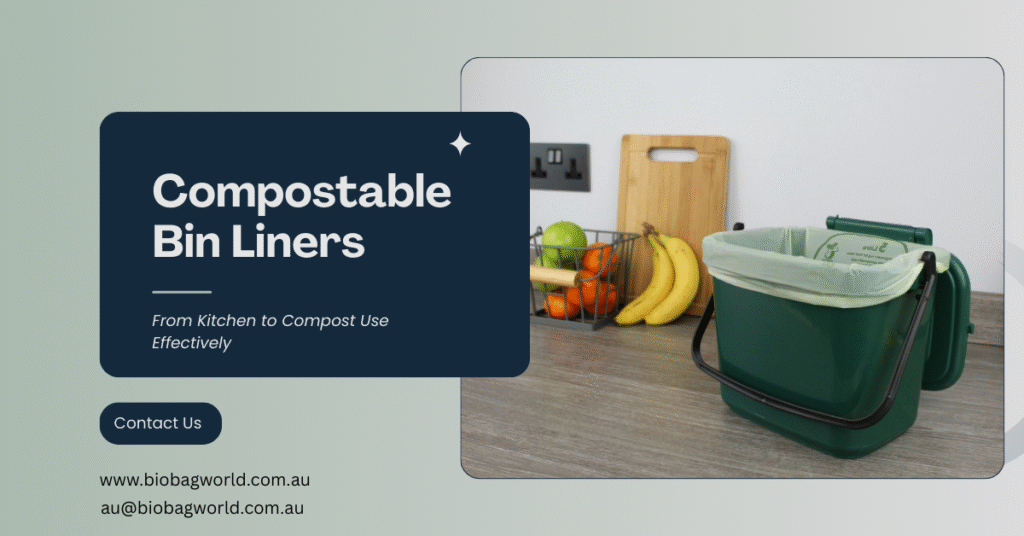As more people seek eco-friendly alternatives in their daily lives, compostable liners have appeared as an easy and impactful way to reduce waste. These liners are not just a passing trend; they are a sustainable solution for reducing plastic pollution and promoting healthier soil. If you have been wondering how to transition to a greener way of managing your kitchen waste, this guide will walk you through the benefits and best practices for using compostable bin liners in your home.
What are Compostable Bin Liners?
These bin liners are an environmentally friendly alternative to traditional plastic bags. Unlike plastic, which can take hundreds of years to decompose, these liners are designed to break down naturally under the right conditions. They are typically made from plant-based materials such as cornstarch, polylactic acid (PLA), or other renewable sources, which means they break down into organic matter that can enrich soil, rather than contributing to landfill waste.
While the terms compostable and biodegradable are often used interchangeably, it is important to note the difference. Compostable products meet specific standards and will break down into non-toxic substances, ideally in a composting environment. In contrast, biodegradable bin liners might break down in landfills, but the process is often slow, and they may not decompose completely without the right conditions.
For the best results, it is essential to look for certified compostable bags, often labelled with standards, which indicate they meet Australian requirements for home or industrial composting.
Why Choose Compostable Bin Liners?
Switching to compostable liners is one of the simplest yet most effective changes you can make to reduce your carbon footprint. These bags serve as an essential part of a larger movement toward more sustainable waste management practices. Here’s why you should consider making the switch:
- Reducing Plastic Waste: Each year, millions of plastic bags end up in landfills, polluting oceans and harming wildlife. By replacing your plastic liners with compostable alternatives, you contribute to cutting down on plastic pollution.
- Supporting a Circular Economy: These bin liners help create nutrient-rich compost that can improve soil health. Instead of sending waste to a landfill, where it contributes to methane emissions, composting turns organic waste into a valuable resource for gardeners, farmers, and composting programs.
- Healthier Soil and Gardens: The compost produced by compostable liners contains nutrients that can help gardens thrive. Whether you are growing veggies at home or donating to community gardens, composting is an easy way to enrich the soil while reducing waste.
Step-by-Step Guide to Using Compostable Bin Liners in Your Kitchen
Making the switch to compostable liners does not have to be complicated. Here is a step-by-step guide to using them effectively:
1. Choose the Right Compostable Bin Liner
The first step is selecting a high-quality compostable bin liner that fits your kitchen needs. Compostable liners come in different sizes, so it is important to pick one that fits your bin snugly. Look for products that are certified compostable, such as compostable bags for compost bin, which are specifically designed for food scraps.
When choosing a liner, check the packaging for labels such as AS4736 or AS5810, which assure that the liner meets Australian composting standards. Ensure the material is sturdy enough to handle the weight of your kitchen scraps, but still breathable enough to break down in a composting environment.
2. Set Up a Kitchen Composting System
Once you have got your compostable liners, it is time to set up your composting system. The easiest way to compost at home is by using a compost bin in your garden or backyard. If you do not have outdoor space, you can look into local council composting programs or start a small worm farm.
To get started, place your compostable bin liner in a dedicated kitchen bin for food scraps. Keep your kitchen composting system near your food prep area for easy access. Ensure to collect only the appropriate scraps, fruit and vegetable peels, coffee grounds, eggshells, and other plant-based waste. Avoid adding meat, dairy, or oils, as these can attract pests and disrupt the composting process.
3. Fill Your Bin and Keep It Organised
As you collect food scraps, make sure you are not overloading the bin or adding items that should not be composted. The key to effective composting is balance: ensure you are adding an equal mix of wet and dry materials. Once your compostable bin liner is full, tie it up securely and place it in your outdoor compost bin or drop it off at a local collection point if your council offers organic waste services.
4. Dispose of the Liner Properly
When it is time to dispose of your compostable bin liner, ensure that you place it in a composting environment where it can break down. Compostable bags, unlike plastic, need the right conditions—heat, moisture, and air circulation—to decompose effectively. Simply drop the liner into your compost heap, ensuring that it is properly aerated and managed for optimal decomposition.
5. Avoid Contamination
One of the major challenges with composting is contamination. For your compostable bin liner to decompose efficiently, it is crucial to keep it free from non-compostable items. Be cautious about placing plastic-wrapped food or items, cleaning wipes into your compostable bag. These will not break down and will cause problems in the composting process.
Myths About Compostable Bin Liners
There are several myths surrounding compostable liners that need to be addressed:
Myth 1: These bin liners break down in any environment.
In reality, compostable products need the right conditions to decompose properly. Landfills lack the necessary heat and air circulation for composting, which is why it is important to use compostable liners in a compost bin or via a local organic waste service.
Myth 2: Compostable bags are a perfect replacement for plastic in every situation.
These liners are great for organic waste, but still require proper disposal. If not composted, they may end up in a landfill, where they can still cause harm. Always ensure your liners are disposed of in a composting or organic waste stream.
Conclusion
The simple act of switching to compostable bin liners can have a significant impact on your waste reduction efforts. These liners not only help you minimise plastic use, but they also contribute to creating healthy compost that supports sustainable gardening practices.
By using compostable bags for compost bins or other certified compostable products, you are taking a vital step toward a more sustainable future. So why not make the change today? Whether you are in a city or the countryside, composting with compostable liners is a straightforward and effective way to reduce your environmental footprint and help build a greener, healthier Australia.



